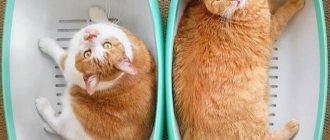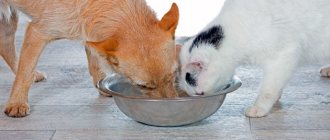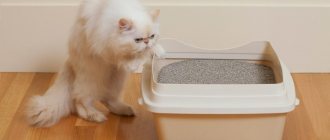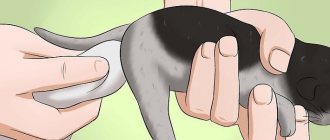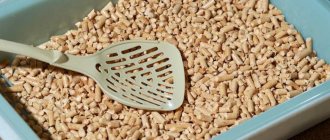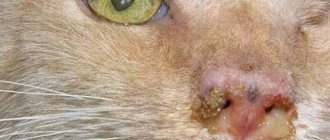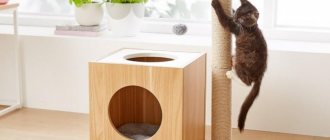How to wash a cat's litter box and how to remove urinary stones? A huge number of owners of domestic cats and especially cats are looking for the answer to this question every day. For those who do not yet have a furry pet, but the thought of the need to acquire a new friend has not left for a long time, such knowledge will also not be superfluous.
First of all, future owners study information about the rules of nutrition and keeping animals. But in the realities of life, people most often face not so much these difficulties as the problem of the smell emanating from the cat’s potty. This will especially complicate life for those who keep the animal exclusively at home, without letting it go outside at all. Daily washing of the tray for collecting feces eventually ceases to relieve the stench, and the “cat spirit” can already be felt far beyond the confines of the bathroom. This happens not because the tray was not washed, but because it was done incorrectly. Increased odor may also be caused by urinary stone growths.
For a comfortable neighborhood, you need to learn as much as possible about the proper care of cats and their litter boxes. The nuances of washing and the secrets of preventing odor will be revealed in this article. Choose the appropriate option for yourself and enjoy living together with a fluffy and mustachioed purring bundle!
How can you wash a cat's litter box without litter to prevent it from smelling? how to clean it from urinary stone?
How to wash a cat's litter box and how to remove urinary stones?
A huge number of owners of domestic cats and especially cats are looking for the answer to this question every day. For those who do not yet have a furry pet, but the thought of the need to acquire a new friend has not left for a long time, such knowledge will also not be superfluous. First of all, future owners study information about the rules of nutrition and keeping animals. But in the realities of life, people most often face not so much these difficulties as the problem of the smell emanating from the cat’s potty. This will especially complicate life for those who keep the animal exclusively at home, without letting it go outside at all. Daily washing of the tray for collecting feces eventually ceases to relieve the stench, and the “cat spirit” can already be felt far beyond the confines of the bathroom. This happens not because the tray was not washed, but because it was done incorrectly. Increased odor may also be caused by urinary stone growths.
For a comfortable neighborhood, you need to learn as much as possible about the proper care of cats and their litter boxes. The nuances of washing and the secrets of preventing odor will be revealed in this article. Choose the appropriate option for yourself and enjoy living together with a fluffy and mustachioed purring bundle!
Caring for your cat's litter box
Caring for your cat's litter box is not difficult. The main actions of the cat owner are:
- timely cleaning of solid animal feces;
- regularly changing urine-soaked litter in the container;
- washing the tray.
If all actions are carried out regularly and in full, then the animal will not relieve itself by passing or do it in unintended places.
Animals from the order of cats are distinguished by their intelligence and have excellent memory. Their habit is to bury the products of their vital activity in the ground so that “enemies” cannot find them by smell. This is why cat litter is filled with cat litter. Also, by smell, they find pairs for procreation, mark and limit “their” territory, and the kittens, thanks to their heightened sense of smell, find the litter box and become accustomed to visiting it. And that is why adult animals ignore places to relieve themselves that are kept in poor order by the owners of the animals.
Dietary disorders, stress, age-related changes in the animal’s body and other external factors lead to the animal’s urine becoming caustic and salts forming in it. Fresh deposits can be removed when replacing the filler, but uric acid or oxalates can only be removed mechanically.
By my rules
Proper washing of the cat's litter box is the key to freshness and a pleasant smell in the apartment. The sequence of actions of this process depends entirely on the design and shape of the cat litter being used.
Open trays need to be cleaned more often than closed trays. Daily cleaning generally does not require a complete change of litter; it will be enough to collect the excrement and then dispose of it in accordance with the recommendations indicated on the packaging of the desiccant mixture.
If the cat relieves itself not in the litter itself, but on the grate, then it is recommended to wash it with each cleaning. For this purpose, it is advisable to use special products designed for sanitizing cat litter. The action of such products is aimed at the complete sanitization of cat litter, so the substance can easily cope with the smell of urine and prevent the deposition of salts.
General cleaning of the cat litter is carried out in the order listed below:
- Empty the tray. Unused filler (especially silicone) can be collected in a separate container and reused.
- Fill the tray with warm water up to the ears, and soak the grate in a separate container.
- We leave the tray with water for ten minutes, and then rinse it and drain the water from the pan.
- Place the tray and grill in a bowl of soapy water, and then leave them there for half an hour.
- After the time has passed, drain the dirty water and treat the surface of the cat litter with a detergent and then scrub with a brush.
- Carefully rinse off any remaining soap and rinse the containers clean.
- We wipe the tray and grill dry or dry it in the fresh air.
Some cat owners recommend having two replaceable trays so that the animal does not experience discomfort while sanitizing its litter box.
Despite the fact that a cat or cat is undoubtedly a favorite, and caring for them is not a burden or disgusting, all work on disinfecting a cat's litter box should be done exclusively with rubber gloves. This will not only protect the skin of your hands from exposure to household chemicals, but also protect against toxoplasmosis. This disease is especially dangerous for pregnant women. Its causative agent, entering the body of the expectant mother, can cause deformities and other abnormalities in the child in the womb.
To wash all parts of the tray, you can use traditional detergents and chlorine-containing substances (Domestos, Belizna and others), as well as special compounds that eliminate the smell of cat urine. When disinfecting the toilet with special chemicals, there is no fear of the formation of urinary stones on the surface of the container. Sprays and powders not only eliminate simple dirt and the specific smell of urine, but also fight pathogens.
If you do not have such means, then you can wash the trays with laundry detergent or any detergent compositions, including improvised ones. But as a result of this, everyone will inevitably have to face other problems. Read about them and their solution below.
Clearing urinary stones
Often, cat owners wash the litter box just to keep the smell out of it. But they forget that untimely or incorrect cleaning of the tray, as well as the use of inappropriate surface treatment products, lead to the deposition of urinary stones. The manifestations of this unpleasant phenomenon are:
- foul odor;
- plaque, noticeable as growths that are rough to the touch;
- refusal of the animal to visit the tray.
An animal that relieves itself in a tray with stone deposits will spread the “aroma” throughout the apartment on the pads of its paws. To avoid urine transfer, and with it possible infection, attention should be paid to combating natural salts.
You can wash off urinary stones using various means, including:
- special ones designed for processing cat litter;
- traditional, used for cleaning toilets and removing urinary stones;
- traditional ones, such as vinegar, baking soda and regular laundry soap.
Stone removal using household chemicals is quick. Active substances that react with salts destroy the structure of the latter and turn them into a soft substance. All you need to do when cleaning the cat litter box is to apply the product, strictly following the recommendations, and then rinse it off with plenty of water.
The rules for using the available substances listed above will be discussed in the table.
How often should I change
Even with regular hygiene procedures, the cat litter box does not have an unlimited shelf life. Like other accessories for animals, it also tends to wear out. The pet himself unconsciously makes “efforts”: he scratches his toilet with his claws, and a white coating may appear at the bottom of the base. Sooner or later, the owner must worry about purchasing a new attribute for his ward.
If cleaning is done on a regular basis, the toilet area can last for several years. However, ignoring the basic rules of care, the stench and particles of waste “eat” into the surface of the tray so that no cleaning products can help. And you can make purchases almost every year.
The tray is placed in a place convenient for the cat
Tray selection
Regular removal of excrement from the cat litter box, timely change of litter and periodic general cleaning will ensure the absence of unwanted odor in the house. But what if the owner does not have the opportunity to clean the toilet with the required frequency? In this case, you should take a closer look at special trays that do not allow the smell to spread.
Such a toilet not only keeps all the aromas inside, but also minimizes the scattering of the filler when buried. It is also perfect for those pets who do not like to relieve themselves in front of everyone. Manufacturers offer a wide selection of models with or without a door, corner and straight toilets.
This is a fairly large product, equipped with a carbon filter and a fan. It eliminates unpleasant odors well, but requires regular filter changes.
You can learn about the intricacies of choosing a cat litter box from the video:
With automatic cleaning
These types of trays are high-tech devices that are capable of sifting, collecting and removing contaminated filler, using sewerage and water supply. The price of such toilets is quite high, but the owners do not have to waste time on cleaning and endure unpleasant odors.
As practice shows, owners who keep their cat litter clean do not encounter such a problem as an unpleasant odor. We hope that our tips will help simplify the process of cleaning up after your pet.
Some more useful information is presented in the video below:
Text: Nadezhda Chernobay
Found a mistake? Select the text with the mouse and click:
If your favorite things show the first signs of gestation in the form of untidy pellets, you can get rid of them using a special machine - a shaver. It quickly and effectively shaves off clumps of fabric fibers and returns things to their proper appearance.
Threads made of gold and silver, which were used to embroider clothes in the old days, are called gimp. To obtain them, the metal wire was pulled for a long time with pliers to the required fineness. This is where the expression “to drag out the rigmarole” came from - “to do long, monotonous work” or “to delay the completion of a task.”
There are special traps to combat moths. The sticky layer with which they are covered contains female pheromones that attract males. By sticking to the trap, they are eliminated from the reproduction process, which leads to a decrease in the moth population.
The dishwasher cleans more than just plates and cups. You can load it with plastic toys, glass lamp shades and even dirty vegetables, such as potatoes, but only without using detergents.
The easiest way to remove scale and carbon deposits from the soleplate of the iron is with table salt. Pour a thick layer of salt onto the paper, heat the iron to maximum and run the iron over the salt bed several times, applying light pressure.
Stretch ceilings made of PVC film can withstand from 70 to 120 liters of water per 1 m2 of their area (depending on the size of the ceiling, the degree of its tension and the quality of the film). So you don’t have to worry about leaks from neighbors above.
The habit of using an automatic washing machine “sparingly” can lead to the appearance of an unpleasant odor in it. Washing at temperatures below 60℃ and short rinses allow fungi and bacteria from dirty clothes to remain on internal surfaces and actively multiply.
Fresh lemon is not only suitable for tea: clean dirt from the surface of an acrylic bath by rubbing with half a cut citrus, or quickly wash the microwave by placing a container of water and lemon slices in it for 8-10 minutes at maximum power. The softened dirt can simply be wiped off with a sponge.
Before removing various stains from clothing, you need to find out how safe the selected solvent is for the fabric itself. It is applied in a small amount to an inconspicuous area of the item from the inside out for 5-10 minutes. If the material retains its structure and color, you can move on to stains.
Ways to get rid of odor
Cats are one of the most common pets. Manufacturers of pet products offer a large number of different products to get rid of the smell of cat litter. Resourceful housewives, in turn, instead of expensive chemicals, use improvised means to effectively clean the animal’s tray.
What does chemical production offer?
Relatively recently, cat owners used improvised means such as pieces of newspaper, sand and sawdust as filler. They absorbed liquid quite well, and the sawdust even absorbed the unpleasant odor. However, the paper had to be changed frequently, and sand and sawdust quickly spread throughout the house. Today, many special fillers are produced that have a large number of advantages.
Wood pellets are the most popular and sought after cat litter.
Fillers for trays are divided into several main types depending on the principle of action and composition:
| Type of filler | Peculiarities |
| Woody | The most popular and inexpensive type of cat litter. It is compressed sawdust that swells when urine comes into contact with it. Wood is a natural hypoallergenic material that perfectly absorbs unpleasant odors. Suitable for cats of any age and breed. The only drawback is that it smells unpleasant when cleaning |
| Corn | This is another option for natural filler. It is made from corn cobs. The result is a composition that can absorb liquid well and retain odors. The only drawback is its lightness, due to which the grains quickly spread throughout the house. |
| clumping | It is a mixture of bentonite clay and minerals. When moisture gets in, it turns into a lump, which can be easily removed using a special scoop. Manufacturers offer flavored and neutral mixtures consisting of large or small granules. It is not recommended to use this litter for kittens, as accidental ingestion is dangerous for the health of the animal. |
| Zeolite | It is made from volcanic minerals - zeolites. Supplied in the form of granules that can quickly absorb liquid and absorb odors. In this case, urine is absorbed not only into the top layer of the filler, but is distributed evenly over all granules. Very economical: if you fill a tray with a layer of at least 5 cm, you will have to completely change the filler no more than once a week |
| Silica gel | The most modern and expensive type of filler. It consists of transparent synthetic crystals that are able to absorb large amounts of liquid while remaining dry. Despite the high cost, it is very economical: if you fill it in a tray with a layer of 5 cm, a complete replacement of the filler will be needed in two to three weeks (per animal). In addition, it has a pronounced antibacterial effect. The only drawback is the sharp edges of the crystals and the loud rustling sound, which can scare away the animal |
The video below clearly demonstrates the properties of various modern fillers:
Regardless of which filler is chosen, owners should monitor its condition and change it as it becomes dirty. Moreover, cats are very clean creatures and many of them will not use a dirty litter box. Cleaning will not take much time. All you need to do is remove the contaminated sorbent and add clean material. The frequency of complete litter replacement depends on its type and the number of animals in the house.
Causes of thick plaque that appears
Some cat owners are faced with such a nuisance as a urinary stone in the animal's litter box. This is a coating that hardens over time. Because of it, an unpleasant odor spreads throughout the house. As a result, the cat stops going to such a tray.
Reasons for the appearance of urinary stones in the cat litter box:
- untimely cleaning of the tray;
- improper cleaning;
- Using inappropriate cleaning products to clean the tray.
To prevent the formation of urinary stones and damage to the cat litter, it is necessary to follow certain rules for caring for it.
Need for washing
The need to clean a pet's toilet occurs very often, especially when the animal is an adult. It is not enough to simply change the filler; this will lead to rapid deterioration of the material. If the tray is not washed, the following problems arise:
- an unpleasant odor appears that is absorbed into the material from which the toilet is made;
- microbes multiply and can contribute to the appearance of diseases in the animal;
- fleas appear in the room, laying their eggs in the area where the toilet is located;
- a dirty toilet can lead to animal diseases;
- the animal refuses to go to the tray.
Failure to wash the tray contributes to the accumulation of urinary stones, which often leads to complete unusability of the container.
What should you do to clean it?
If everything already “looks bad” and there is urinary stone in the tray and a literally suffocating smell, do not be upset - you can get rid of both in one intensive procedure. What will she need?
- Respirator and gloves to protect hands and respiratory tract;
- Garbage bag for used litter;
- Water;
- Clean cloth;
- A hard brush, not a kitchen brush, and especially not in grease;
- Detergents.
First of all, you should put on a respirator and gloves - the smell will be less annoying and you won’t be afraid of catching common cat parasites. Then the pot should be placed entirely in a garbage bag, turned over and carefully shake out all its contents, lightly tapping the bottom. It is better to throw away the resulting garbage immediately.
Not all animals take chemicals well, so traditional methods of cleaning the tray come to the rescue. The products that almost everyone has in their home will help you deal with formations: vinegar, baking soda and laundry soap. Making a cleaner couldn't be easier.
Add soda to warm water (half a glass will be enough), pour it into a tray and clean the surface with a stiff brush until the stone comes off. If there is a strong unpleasant odor, you will need 2 tablespoons of soda per 0.5 liter of water. Pour the solution into the cat litter and leave it overnight (or several hours). The next morning you can easily wash off the formations.
Vinegar perfectly disinfects and easily removes contaminated areas. In addition, it helps cope with unpleasant odors. Vinegar is added to the tray when cleaning and washed with it. Laundry soap is best used before plaque appears - it keeps the material in good shape and prevents the formation of urinary stones.
How to quickly clean a cat's litter box, watch the video below.
What folk remedies will help wash
To clean your cat's litter box, you don't have to buy expensive store-bought chemicals. The funds available in every home will come to the rescue. The main thing is to know the rules for their use and cleaning methods.
Table vinegar
To clean with table vinegar, you need to heat the substance to forty °C and fill the tray so that all the plaque is in the liquid. In this state, the container should stand for a certain time. If the contamination is shallow, then one hour will be enough. In case of heavy contamination, you must wait at least three hours.
Baking soda
It is used for mechanical stone removal and disinfection. You need to start by washing the tray. Next, dry soda must be poured onto the rough surface and rubbed into the urinary stone with a brush until it is removed. After the procedure, the cat litter box is rinsed again with warm water and dried outside.
Laundry soap
Soap must be dissolved in hot water. A soap solution is poured into a large container and parts of the tray containing urinary stone are placed in it. Next, the tray soaks for 24 hours. After this, the stone is removed with a stiff brush, and the pot is rinsed with water and vinegar.
Mustard powder
Mustard powder is applied to the wet surface of the tray and rubbed with a stiff brush into the surface damaged by the urinary stone. After cleaning, rinse the container with water. This cleaning will not only get rid of the stone, but will also help get rid of animal marks on different surfaces.
Traditional methods
Traditional methods allow you to clean the tray without using harmful household chemicals. We use products that are available in every home.
You can wash your cat's litter using baking soda. To do this, you need to perform the following algorithm of actions:
- clean the pot from the filler;
- wash off any remaining filler;
- Apply a thin layer of baking soda and leave for 5-10 minutes;
- Using a brush, remove the stone and wash the product under running water.
The benefit of using baking soda is that it removes harmful microorganisms. Also, soda can cope with even the most difficult plaque.
Laundry soap
Using soap will allow you to clean the tray if it is only slightly dirty. Laundry soap does not damage the surface of the tray and forms a protective film that prevents the reappearance of the stone. To use, make a thick foam, apply to the tray and rub thoroughly with a brush. Then rinse with water and wipe with a cloth.
Important. If you cannot remove the urinary stone the first time, you can soak the product overnight in a solution of laundry soap.
Useful tips
To keep the tray clean, you just need to monitor it regularly. This means that feces should be removed immediately, the toilet and litter should be of high quality, and the tray should be washed in a timely manner (if you simply wash it with soap, this will prevent the appearance of odors).
Cleaning the toilet after each time your beloved pet goes to the toilet is not always a good idea, because not everyone sits at home and can do this all the time. Then it is advisable to use an odor absorber for the toilet (freshener). The spray is simply sprayed into the filler.
Anyone who has a beloved pet in their home must take a responsible approach to any issues relating to it. Many owners scold their pets if they relieve themselves in inappropriate places. But before you scold your pet, make sure that comfortable conditions are provided for him. After all, it’s not the furry friend’s fault if his owner didn’t take care of the litter box. Proper cleaning ensures that the cat will go to the toilet in the right place, and no one will become infected with dangerous bacteria.
To prevent the appearance of urinary stones and to avoid problems with your animal’s litter box, you need to follow simple rules for caring for your cat’s litter box:
- Clean your cat's litter box daily. To do this, just drop any liquid product onto the bottom of the tray and rinse under running water.
- Before adding the filler, add half a pack of soda to the bottom of the pot to extend the shelf life of the filler and prevent the appearance of an unpleasant odor.
- After a year of operation, replace the tray with a new one.
- Cleans the tray at times when the animal does not need it.
- Clean quickly, without delay, especially if there is no second toilet.
- Do not fill the tray with products that remove the smell of the animal.
- Use high-quality fillers to prevent the appearance of unpleasant odors.
- For an adult, use fillers with large granules.
- Buy only quality toilets. The rate of formation of urinary stone on its surface depends on this.
- Do not add citrus-scented deodorizing agents to the litter - this will scare the animal away and it will not go into the litter box.
- Do not use cleaning products with a citrus scent.
The cleanliness of the litter box determines not only whether the cat will go in it or not, but also its health. Due to untimely cleaning or improper cleaning, pathogenic microbes may appear in the tray.
Why is this necessary?
Many people believe that changing the litter will eliminate the smell, but this is not true. If you are indifferent to the state of your pet’s toilet, then he will prefer to relieve himself in other places - for example, next to the tray or on some things. The cat goes to the toilet “in the wrong place” not because he is being mischievous, he is simply by nature accustomed to relieve himself where there is no smell and where it is clean .
Lack of proper care can lead to the deposition of urinary stones (a plaque consisting of mineral and lime deposits). This is the main source of unpleasant odor in the entire apartment.
You can clean the cat litter box from plaque with ordinary detergents, but it is important to rinse them thoroughly, because cats do not perceive chemical odors well.
Another reason why you should be more careful about your furry friend's litter box is the occurrence of an infectious disease called toxoplasmosis. The infection is caused by parasites that are found in the feces of animals that are infected. Feces must be removed immediately after the cat relieves itself, because humans can also become infected with toxoplasmosis.
Please note: if you regularly wash the tray, the listed problems will bypass you. It needs to be thoroughly cleaned once a week.
How to wash a cat's litter box?
It is almost impossible to teach even the smartest cat to go to the toilet on a schedule. Pets that have access to the street and relieve themselves outside the apartment or house go for a walk and “run errands” several times a day, while domestic cats use the litter box. Some owners prefer to pour various types of litter into the cat litter box, while others leave the bottom of the litter box. Regardless of how the tray is used, it needs to be washed regularly. How to wash a cat's litter box? Below we will look at the most popular means that can effectively get rid of the smell in the cat's litter box and wash away dirt.
Preparation
At first glance, it may seem that washing your pet’s litter box to get rid of the smell is an elementary task, but you should approach it with all responsibility and according to all the rules. This ensures that the animal will be comfortable going to the toilet, and no unpleasant odors will appear in the apartment.
The step-by-step preparation is as follows.
- There should always be a trash can next to the cat's litter box. The bucket will prevent the floor from getting dirty.
- It is advisable to purchase rubber gloves and a protective mask at the pharmacy. It is advisable to wear both each time you need to clean the tray.
- To clean your pet's toilet, you will need tools such as a brush, gloves, laundry soap, a trash can, a mask, baking soda, and litter (it can be replaced with sand).
Daily cat litter box hygiene
If the cat owner uses odor-absorbing litter, it is still a good idea to clean up the cat's excrement daily as it comes out. Clumping litters allow you to remove not only feces, but also urine, as they “catch” moisture, forming fragments that are easy to clean. All you need for cleaning is a special scoop that can be used to scoop up the soiled litter without touching it with your hands.
Non-clumping litters (for example, silica gel or wood) simply absorb cat urine without turning into lumps. Therefore, it is not possible to completely remove the liquid; therefore, daily cleaning consists only of removing feces from the pot. For this, again, a spatula is used.
Cat litter box with clumping litter
If the tray has a mesh on top, some owners do not consider it necessary to spend extra money on filler. When a cat urinates, liquid gets inside, and the animal's paws remain dry, as they are on the mesh. Solid excrement also remains on top, so they need to be removed once or twice a day, and the mesh itself needs to be washed.
Urine that has accumulated at the bottom of the tray should also be poured out regularly (ideally, as many times as the cat goes to the toilet to avoid the smell), and the tray should be washed. For these purposes, you can use different means, the main thing is that they do not have a strong odor that can repel the animal from the toilet area.
Tray with mesh does not require filler
For daily cleaning of cat litter, any antibacterial or unscented baby soap will do. After the tray is rinsed under running water (you need to use only cold water, since when it comes into contact with boiling water, cat urine begins to smell strongly and unpleasantly), it needs to be washed with a sponge with a soapy solution, then rinsed again under cool water. There is no point in drying the plastic; you can vigorously shake the product several times and then wipe it with an old rag.
In principle, daily hygiene of the cat potty does not require special care, so any detergent available in the house, for example, dishwashing detergent or floor cleaner, will do. Some owners specifically purchase inexpensive household chemicals suitable for cleaning plastic, choosing products with a neutral odor.
Liquid antibacterial soap is perfect for everyday cleaning of the tray
General cleaning of the cat potty
Although using hygienic litter for cats reduces daily cleaning efforts, it requires thorough washing at least once a week. It is necessary to clean the cat litter not only because the smell spreads from it, but also so that the cat does not want to “do business” in the right place, and does not choose a more secluded and clean corner. An attentive owner will not allow a strong odor to appear from the tray, already knowing how often cleaning should be done. What is required for this?
Preparing to clean your cat's litter box
To quickly and effortlessly wash your cat’s weekly litter box, you should prepare the following:
- rubber gloves and respirator mask;
- spacious garbage bag;
- detergent (we will talk about the choice below);
- sponge or cloth.
Using gloves will help avoid infection with parasites or toxicoplasmosis.
Cleaning process
The old filler needs to be shaken out into a bag, putting it on the tray so as not to spill. The garbage bag must be tied tightly immediately, preventing the smell from leaking out. Check that the bag does not have holes, otherwise there is a high chance of spilling soiled filler throughout the apartment. If you are not using pot filler, this step is of course unnecessary. Next, you need to take the tray to the bathroom, rinse thoroughly under running cold water, and then begin cleaning it with detergent.
Over time, stains may form on the bottom and walls of the cat's litter box, as well as urine stone, which has a persistent unpleasant odor. It is not so easy to wash away the consequences of a cat visiting the toilet, but using proven products, the owner can achieve pristine purity of the plastic. You can use both folk remedies and store-bought ones.
Life hack: some owners specifically buy an inexpensive toilet brush and use it to clean the cat’s litter box. It is very comfortable! After washing the tray, the toilet brush is rinsed with cleaning agent and put into the stand.
Video - Washing the tray from urinary stones
Products for cleaning cat litter
In order to thoroughly clean your cat's litter box and get rid of the smell, you can use available household products, such as baking soda or diluted vinegar. These products perfectly remove unpleasant odors and clean plastic. Soda should be poured onto a damp sponge or directly into the tray, and then rubbed thoroughly until completely dissolved. Table vinegar is simply poured into the tray, rinsing it. You can also use antibacterial or even laundry soap.
Important point! Do not use lemon to neutralize odor, or any product that has a citrus scent. Cats cannot stand the smells of lemon, lime and orange, so they can easily refuse to go to the potty.
Many cats have an aversion to the smell of citrus fruits.
Also, commercial products designed for cleaning and disinfecting plastic are well suited for washing trays. For severe contamination, you can use toilet bowl cleaners, for example, Domestos or Komet; Pemaxol or other cleaning powders cope well with the problem. It is important to thoroughly rinse the cleaning agent from the tray so that the animal is not poisoned by inhaling the chemical.
After the tray is washed, you need to wipe it dry and fill it with filler or install a mesh (this is also pre-washed).
Life hack: first, you can put a thick garbage bag on a clean tray, and then pour filler into it. When the next cleaning time comes, the bag can be pulled out along with the dirty filling and immediately tied.
Disposable trash bags make cleaning a lot easier
Why does the cat walk by
If the animal does not walk in the tray, but near it, the following causes of the problem may be:
- the tray is not selected according to the size of the animal;
- the filler is not suitable;
- the pot is dirty.
It is necessary to carefully study the behavior of the animal and only then make a decision.
Helpful Tips for Cleaning Your Cat's Potty
- Daily cleaning can be done by simply dropping detergent into the tray and then running it under running water to create a foam.
- Before pouring the filler into the tray, add half a pack of baking soda to the bottom - this will prolong the freshness of the filler and hide the unpleasant odor.
- About once a year, the cat's litter box needs to be replaced with a new one. No matter how thoroughly the cleaning is done, plastic accumulates odors over time. At first, pour the already used filler into the new tray, or place the old mesh in a new tray.
- You need to choose a time to wash the litter box at a time when the animal usually does not go to the toilet. There is no need to delay the hygiene procedure for a long time if the cat does not have a second tray - the pet may simply not be able to wait until the end of the cleaning.
- Under no circumstances should you use products designed to eliminate animal odor for your cat's potty. A cat can smell an unpleasant or even frightening aroma, and will forever “unlearn” the place reserved for the toilet.
A clean litter box is a must for every cat.
How to remove odor
If the tray stinks even after washing, it is necessary to use special preparations that block the smell. You can also use the proven method and before adding the filler, spread a thin layer of soda on the bottom of the tray. This action will remove the odor and absorb excess liquid.
You can also remove the unpleasant odor using special napkins, which are lined at the bottom of the pot and filler is poured on top. This napkin is effective for a week.
Daily care rules
In order for the urinary stone to be easily cleared, it is necessary to follow the rules of daily cleaning. The rules look like this:
- Clean up feces daily. Regardless of the state in which the filling is, it is necessary to have a special spatula for comfortable removal of waste.
- Remove lumps in litter daily.
- Check the condition of the filler. If it is already dirty, it needs to be replaced.
The filler must be changed for an adult animal every 3-4 days. Daily replacement is not necessary unless there is an unpleasant odor.
To ensure that the daily cleaning of the toilet does not cause difficulties, general cleaning is carried out every 7-10 days. During cleaning, the following precautions must be observed:
- change the filler;
- cleanse urinary stones;
- disinfect the cat litter;
- rinse the product well so that the disinfectant does not get on the cat’s mucous membranes;
- wipe with a napkin;
- add fresh filler.
